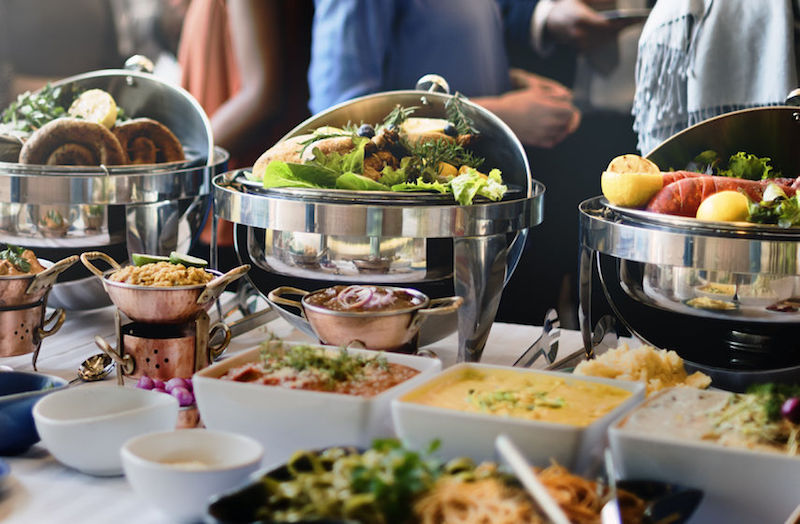
Set your catering budget
Unless you have unlimited funds, you will want to keep costs down while still offering crowd-pleasing fare. If you’re planning a company meeting or event, you’ve probably already been given a budget you need to stick to, but if you need catering for a wedding or reunion crowd, you may have to do some calculations to determine what you can spend.
Regardless of the size (or finality) of your budget as you start to plan, try to have at least a range in mind before you begin to contact potential caterers. If you simply can’t arrive at a number on your own, meet with caterers to get their input. They’ll be able to give you a general idea of what various types of menus cost and help steer you to choices that are within your budget range.
If you don’t yet have any potential caterers in mind, check with the event planning staff at your venue. At the Thrasher-Horne Center, for example, we maintain a list of local caterers/alcohol providers that we’ll be glad to share with you.
Consider your venue
Not every facility can accommodate every type and size of meal, so factor in the capabilities of the venue’s kitchen when you’re figuring out your menu. Again, experienced caterers can tell you what kind of space they need to serve various types of menus. Also, ask your venue’s staff what’s been done there in the past.
Match the menu to the event
The time of day, the number of guests, the type of event, the venue and more will all influence your final choices. Here are some things to keep in mind:
Business meetings or corporate event menus
For a business meeting that starts early and goes all day, you may need to find the balance between keeping everyone sustained until noon and keeping them awake! A breakfast of pastries, coffee and juice is easy and inexpensive, but won’t help attendees stay focused. Consider healthier choices that include whole grains, fruits and vegetables, and eggs or other proteins.
If your corporate event includes lunch, the most important factor may be time. A buffet will encourage attendees to mingle and can keep things moving quickly. Conversely, a sit-down meal will require time for servers to bring out and clear away courses, but will give your guests time to relax for a bit. If it’s a working lunch, speak with your caterer about creative ideas for attractive and tasty boxed lunches.
A large, multi-day corporate event may also include an on-site dinner. Guests may be expecting a substantial meal in the evening, with several choices. Alcohol and dessert are often part of dinner menus, so this is where your budget can be under pressure. Ask your caterer how he or she can help you keep costs within reason, and be sure you fully understand your venue’s rules and policies on serving alcohol. (Insurance mayis typically be required.).
Wedding event menus
Whether it’s a bridesmaids’ luncheon, rehearsal dinner or reception, the food you serve is an important part of the overall impression you want to make and the experience you want to create for your guests.
Once you’ve nailed down the number of guests and the venue (if you need help with that, take a look at our step-by-step wedding planning checklist), it’s time to explore catering options and create a plan. The Knot has some great suggestions in it’s “Tips for Planning a Ridiculously Delicious Menu” article, including:
- Plan for special diets: Some of your guests may follow a vegetarian or vegan diet, or have allergies to nuts, dairy, gluten, shellfish or other foods. Other guests may have religious requirements, such as those who need Kosher items. While you shouldn’t be expected to plan for every possible type of dietary restriction, work with your caterer to make sure you include a range of options for guests who may have special diet needs.
- Choose your style: The range of styles is wider than it’s ever been, from trendy food trucks for an informal outdoor gathering, to formal, sit-down meals with multiple courses. The venue and the time of day factor in as well—guests at a mid-afternoon reception probably won’t need or expect a full meal, but they will need at least a small meal if you’re having a late afternoon ceremony followed by an early evening reception.
- Think seasonal and local: Just like out-of-season flowers can bust your budget, hard-to-get, out-of-season menu items can, too. Ask your caterer for suggestions on what’s fresh and in season in your area.
- Consider safety and simplicity: Think twice about offering food that may not stay safe to eat if it sits out for hours or can’t be kept at a safe temperature. Also, consider what’s easiest for your guests to manage as you plan. Foods that tend to splatter, drip or fall apart should be left off of your menu, even for a sit-down dinner. And, if your menu consists of only passed trays of appetizers to standing guests, think about how guests will balance food and drink at the same time.
Martha Stewart’s wedding website has some additional good advice for “7 Types of Food You Should Never Serve at Your Wedding Reception”: Don’t serve raw onions, anything with spinach (it can get stuck in teeth), or dishes that will weigh down your guests, such as those with butter and cream (save that richness for your beautiful cake).
We’re here to help!
Whether you’re planning a corporate meeting or company event, a wedding, or a celebration, our dedicated staff is available to discuss your needs or give you a tour of our facilities. Contact us today for information on all of our flexible options for your next event.


